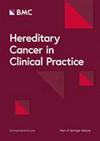作为 BRCA1 携带者癌症风险标志物的血钼水平
IF 2.4
4区 医学
Q3 ONCOLOGY
引用次数: 0
摘要
研究钼的血液水平是否是 BRCA1 基因携带者癌症风险的标志物。研究人员对 989 名最初未受影响的 BRCA1 基因突变女性进行了前瞻性队列研究。研究人员采集了血液样本以测量钼水平,并对参与者进行了平均 7.5 年的随访。在对潜在的混杂因素进行调整后,采用 Cox 比例危险模型评估血钼水平与癌症发病率之间的关系。高血钼(> 0.70 µg/L)与卵巢癌(HR = 5.55;95%CI:1.59-19.4;p = 0.007)和任何癌症(HR = 1.74;95%CI:1.17-2.61;p = 0.007)的发病风险增加显著相关,但与乳腺癌(HR = 1.46,CI = 0.91-2.33;p = 0.12)的发病风险增加无关。十年后卵巢癌的累积发病率为:钼含量最低的三等分组为1.2%,中等的三等分组为4.2%,最高的三等分组为8.7%。血液中钼水平升高与 BRCA1 基因突变携带者罹患卵巢癌的风险增加有关。降低钼水平有可能降低这一人群的癌症风险,而钼水平过高可作为一个标记,考虑对 BRCA1 基因携带者进行预防性输卵管切除术。我们有必要开展进一步的研究来证实这些发现,并探索以钼水平为目标的干预措施,以预防 BRCA1 基因突变携带者患卵巢癌。本文章由计算机程序翻译,如有差异,请以英文原文为准。
Blood molybdenum level as a marker of cancer risk on BRCA1 carriers
To investigate whether Molybdenum blood level is a marker of cancer risk on BRCA1 carriers. A prospective cohort study was conducted among 989 initially unaffected women with a BRCA1 mutation. Blood samples were collected to measure molybdenum levels, and participants were followed for an average of 7.5 years. Cox proportional hazards models were used to assess the association between blood molybdenum levels and cancer incidence, adjusting for potential confounders. High blood molybdenum levels (> 0.70 µg/L) were significantly associated with an increased risk of developing ovarian cancer (HR = 5.55; 95%CI: 1.59–19.4; p = 0.007) and any cancer (HR = 1.74; 95%CI: 1.17–2.61; p = 0.007) but not breast cancer (HR = 1.46, CI = 0.91–2.33; p = 0.12). The cumulative incidence of ovarian cancer at ten years was 1.2% for the lowest molybdenum tertile, 4.2% for the middle tertile, and 8.7% for the highest tertile. Elevated blood molybdenum levels are associated with an increased risk of ovarian cancer on BRCA1 mutation carriers. Lowering molybdenum levels may potentially reduce cancer risk in this population, and high molybdenum levels could serve as a marker for considering preventive oophorectomy in BRCA1 carriers. Further research is warranted to confirm these findings and explore interventions targeting molybdenum levels as a preventive measure for ovarian cancer in BRCA1 mutation carriers.
求助全文
通过发布文献求助,成功后即可免费获取论文全文。
去求助
来源期刊
CiteScore
3.10
自引率
5.90%
发文量
38
审稿时长
>12 weeks
期刊介绍:
Hereditary Cancer in Clinical Practice is an open access journal that publishes articles of interest for the cancer genetics community and serves as a discussion forum for the development appropriate healthcare strategies.
Cancer genetics encompasses a wide variety of disciplines and knowledge in the field is rapidly growing, especially as the amount of information linking genetic differences to inherited cancer predispositions continues expanding. With the increased knowledge of genetic variability and how this relates to cancer risk there is a growing demand not only to disseminate this information into clinical practice but also to enable competent debate concerning how such information is managed and what it implies for patient care.
Topics covered by the journal include but are not limited to:
Original research articles on any aspect of inherited predispositions to cancer.
Reviews of inherited cancer predispositions.
Application of molecular and cytogenetic analysis to clinical decision making.
Clinical aspects of the management of hereditary cancers.
Genetic counselling issues associated with cancer genetics.
The role of registries in improving health care of patients with an inherited predisposition to cancer.

 求助内容:
求助内容: 应助结果提醒方式:
应助结果提醒方式:


